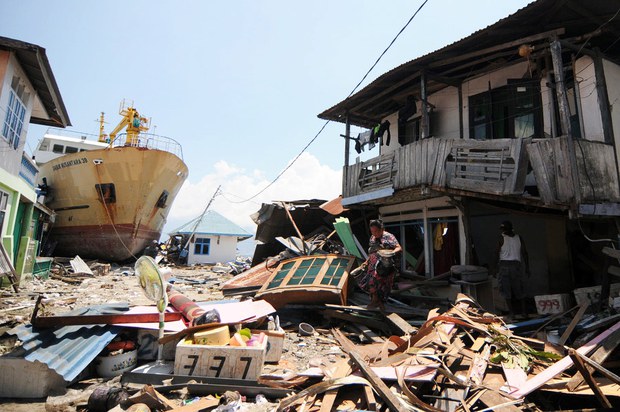Indonesia Quake Aftermath: Desperate Coastal Villagers Plead for Help
2018.10.02
Donggala, Indonesia
 A woman salvages kitchen utensils outside a destroyed house, near a ship swept ashore by a tsunami, in Wani II village of Donggala Regency, Central Sulawesi province, Oct. 2, 2018.
A woman salvages kitchen utensils outside a destroyed house, near a ship swept ashore by a tsunami, in Wani II village of Donggala Regency, Central Sulawesi province, Oct. 2, 2018.
Flattened homes, collapsed bridges and crumbled buildings.
There was devastation as far as the eye could see in Wani II village in Donggala regency, near the epicentre of Friday’s magnitude 7.4 earthquake.
A ship sat next to a house after being washed ashore by the force of the subsequent tsunami.
Villagers, desperate for help, could be seen scavenging and trying to salvage items from the debris.
“Where can I get food? Everything is shut down,” village resident Muhammad Iksan said.
“Even if there were open shops, no one has money,” he said.
Locals said they had chipped in to hire an excavator to clear rubble from the road through the village of about 700 households.
At least 10 residents died in the disaster, while four were still missing, said Andi Abdullah, a local man. But rescue personnel had yet to arrive to take an official count.
“We can’t do everything by ourselves,” Andi said. “We hope rescue teams will come and help us evacuate victims.”
“Come quickly to our village. Don’t just pay attention to Palu. We also need help here,” Sukri, another villager, told BenarNews.
Death toll
The death toll from the twin disasters that devastated parts of Indonesia's Sulawesi island rose to 1,374, an official said Tuesday, as authorities struggled to bring aid to survivors.
At least 799 were injured and 113 others were reported missing after Friday's disaster, Willem Rampangilei, head of National Disaster Management Agency, told a news conference in Palu.
The agency’s spokesman, Sutopo Purwo Nugroho, said more than 61,000 were displaced.
Most of the casualties recorded thus far were in the city of Palu, the capital of Central Sulawesi province, while the extent of the disaster in other affected areas, such as Donggala and Sigi, had yet to be fully revealed.
Across the affected areas, anger was growing at the slow pace of aid. Indonesian boats carrying food and water had yet to arrive, officials said. TV news footage showed widespread looting.
Police had arrested 45 people accused of looting shops in Palu, national police spokesman Dedi Prasetyo said.
Goods stolen include flat-screen television sets, shoes, clothes and even an ATM machine, he said.
Officials said food, fuel and heavy machinery were being sent, and that power and communications were slowly being restored. Widespread fuel shortages were reported by multiple agencies and news photographs showed hundreds of people queuing at a gas station.
"Food supplies are being sent by air and sea and now also by land," said Wiranto, the coordinating minister for political, legal and security affairs. "The volume is growing."
Sutopo, the disaster agency spokesman, acknowledged that aid had not reached many displaced people.
"Food is limited, fuel is limited and clean water and clothing are insufficient," he said.
He said reports that food trucks had been stopped by quake survivors before reaching worst-hit areas were true.
“Police have been assigned to guard food convoys,” he said.
![20181002-ID-Donggala-inside620.JPG A man walks near collapsed homes in Wani II village of Donggala Regency, days after a powerful earthquake and a tsunami struck Central Sulawesi province, Oct. 2 2018. [Keisyah Aprilia/BenarNews]](/english/news/indonesian/Indonesia-quake-10022018132248.html/20181002-ID-Donggala-inside620.JPG/@@images/baa6b8b8-a537-44e8-962f-77dc83b3cac0.jpeg)
Man pulled alive from collapsed building
Rescuers pulled a man alive from the ruins of an office building where he was working in Palu, a video released by the National Search and Rescue Agency showed.
Sapri Nusin, a manager at a finance company, was trapped under a concrete slab but was fully conscious when rescued.
"Can you stand?" a rescuer asked the survivor. "Yes, but I'm very thirsty," he replied as rescuers took him into an ambulance.
The Indonesian Red Cross said its volunteers had recovered the bodies of 34 students who were buried by a mudslide while taking part in a Bible camp at a church in Sigi regency.
The church had earlier reported that 86 students were missing after Friday's earthquake, said the relief agency’s spokeswoman, Aulia Arriani.
"The hardest part was wading through the mud for one and a half hours carrying dead bodies," she said, citing the account of the search team.
She said that volunteers estimated that 50 percent of houses in Sigi were damaged by the earthquake.
Elsewhere on Tuesday, a magnitude 6.3 quake rattled Sumba island, about 2,000 km (1,250 miles) south of Central Sulawesi province.
The quake caused minor building cracks, but there were no report of casualties, according to Martina D. Jera, head of the disaster management agency in East Sumba regency.
At least 26 countries have offered emergency assistance, disaster agency spokesman Sutopo said. Indonesian President Joko Widodo authorized the acceptance of international aid on Monday.
Australia said it had provided AU$500,000 (U.S.$360,000) through the Indonesian Red Cross and the United States announced on Monday that it had released $100,000 in initial disaster assistance.
Indonesia sits on the Pacific Ring of Fire, an area known for seismic upheavals and volcanic eruptions. About 230,000 people in a dozen countries died after a magnitude 9.1 earthquake off the west coast of Indonesia's Sumatra island spawned a devastating tsunami on Dec. 26, 2004.
Ahmad Syamsudin in Jakarta contributed to this report.
![finalgraphic-01.jpg Graphic shows the epicenter and impact zone of the earthquake that struck Central Sulawesi on Sept. 28, 2018. [Vincent Meadows/BenarNews]](/english/news/indonesian/Indonesia-quake-10022018132248.html/finalgraphic-01.jpg/@@images/0a344546-6687-4e6f-bde8-574e80659bc3.jpeg)







